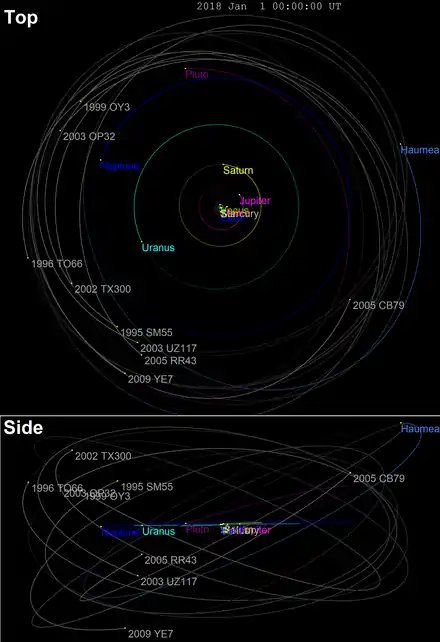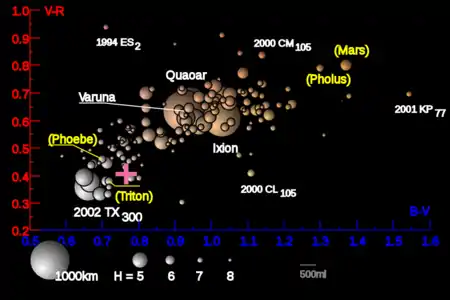(308193) 2005 CB79
(308193) 2005 CB79 is a trans-Neptunian object that is a member of the Haumea family.[9]
 (308193) 2005 CB79 among other Haumea family objects | |
| Discovery[1] | |
|---|---|
| Discovered by | M. E. Brown, C. A. Trujillo, D. L. Rabinowitz |
| Discovery date | 6 February 2005 |
| Designations | |
| 2005 CB79 | |
| Cubewano (MPC)[2] Extended (DES)[3] | |
| Orbital characteristics[4] | |
| Epoch 13 January 2016 (JD 2457400.5) | |
| Uncertainty parameter 4 | |
| Observation arc | 5083 days (13.92 yr) |
| Aphelion | 50.062 AU (7.4892 Tm) (Q) |
| Perihelion | 37.231 AU (5.5697 Tm) (q) |
| 43.647 AU (6.5295 Tm) (a) | |
| Eccentricity | 0.14698 (e) |
| 288.36 yr (105324 d) | |
| 319.66° (M) | |
| 0° 0m 12.305s / day (n) | |
| Inclination | 28.606° (i) |
| 112.79° (Ω) | |
| ≈ 5 December 2048[5] ±3 days | |
| 90.154° (ω) | |
| Physical characteristics | |
| Dimensions | 158 km[6][7] |
| 6.76 h (0.282 d) | |
Sidereal rotation period | 13.52 h[8] |
| 0.7 (assumed) | |
| (Neutral) B-V=0.73, V-R=0.37[9] | |
| 21.1[10] | |
| 4.6[4] | |
Haumea family
As a member of the Haumea family, (308193) 2005 CB79 is suspected of being an icy mantle collisional fragment from dwarf planet Haumea. With an absolute magnitude (H) of 4.7,[4] and a Haumea-family albedo of 0.7, this object would have a diameter of 158 km.[7]
Observations by Mike Brown in 2012 using the W. M. Keck Observatory suggest that (308193) 2005 CB79 does not have a companion.[11]

The + marks 2005 RR43 (B-V=0.77, V-R=0.41) on this color plot of TNOs. All the other Haumea-family members (2005 CB79: 0.73, 0.37) are located to the lower left of this point.
References
- Marsden, Brian G. (September 1, 2007). "MPEC 2007-R02 : 2003 UY413, 2003 UZ413, 2004 NT33, 2005 CA79, 2005 CB79, 2005 UQ513". IAU Minor Planet Center. Harvard-Smithsonian Center for Astrophysics. Retrieved January 10, 2010.
- "MPEC 2010-A05 :Distant Minor Planets (14 January 2010.0 TT)". IAU Minor Planet Center. January 2, 2010. Archived from the original on 14 January 2010. Retrieved January 10, 2010.
- Marc W. Buie (December 20, 2008). "Orbit Fit and Astrometric record for 308193". SwRI (Space Science Department). Archived from the original on August 18, 2010. Retrieved January 10, 2010.
- "JPL Small-Body Database Browser: (2005 CB79)". December 20, 2008. Retrieved 7 April 2016.
- JPL Horizons Observer Location: @sun (Perihelion occurs when deldot changes from negative to positive. Uncertainty in time of perihelion is 3-sigma.)
- Assuming a Haumea-like albedo of 0.7
- Dan Bruton. "Conversion of Absolute Magnitude to Diameter for Minor Planets". Department of Physics & Astronomy (Stephen F. Austin State University). Archived from the original on March 23, 2010. Retrieved December 27, 2009.
- Carry, Benoit; Snodgrass, Colin; Lacerda, Pedro; Hainaut, Olivier; Dumas, Christophe (16 July 2012). "Characterisation of candidate members of (136108) Haumea's family: II. Follow-up observations" (PDF). Astronomy & Astrophysics. EDP Sciences. 544. arXiv:1207.6491. Bibcode:2012A&A...544A.137C. doi:10.1051/0004-6361/201219044. Archived from the original (PDF) on 7 November 2014. Retrieved 8 June 2014.
- Snodgrass, Carry; Dumas, Hainaut (16 December 2009). "Characterisation of candidate members of (136108) Haumea's family". Astronomy and Astrophysics. arXiv:0912.3171. Bibcode:2010A&A...511A..72S. doi:10.1051/0004-6361/200913031.
- "AstDys 2005CB79 Ephemerides". Department of Mathematics, University of Pisa, Italy. Retrieved January 10, 2010.
- Plutokiller (February 3, 2012). "2005 CB79 looks solitary". Twitter. Retrieved February 3, 2012.
External links
This article is issued from Wikipedia. The text is licensed under Creative Commons - Attribution - Sharealike. Additional terms may apply for the media files.
